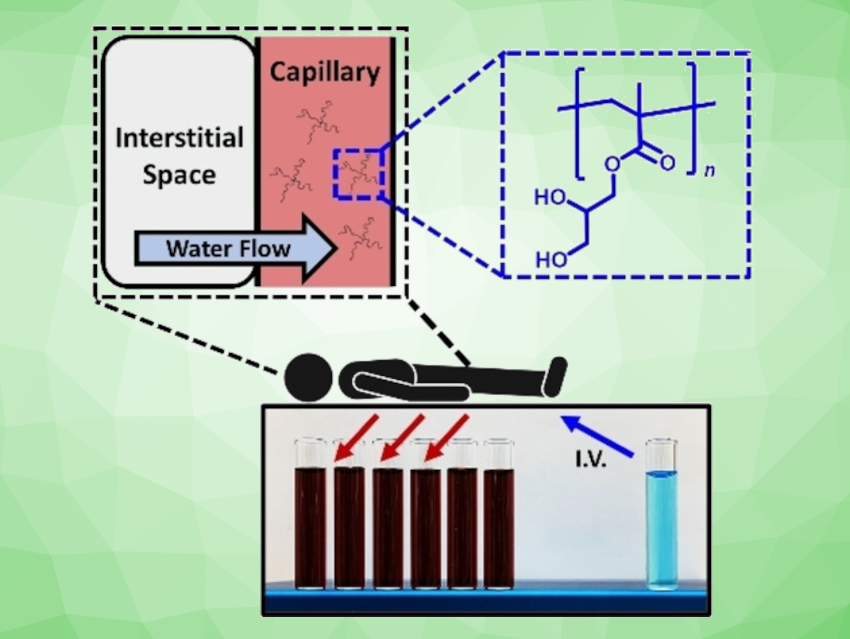Extensive blood loss after injuries is life-threatening and must be counteracted as fast as possible. Relatively small-volume injections of solutions of a new star-shaped polymer, developed by Nathan J. White, Suzie H. Pun, University of Washington, Seattle, USA, and colleagues, could compensate for the loss of fluid without disrupting coagulation. This makes it particularly interesting for preclinical treatment of hemorrhagic shock.
Severe Blood Loss
Traumatic injuries account for a large portion of morbidity and death—in the USA, they are the primary cause of death in people under 46 years of age. In cases of heavy blood loss, time is a critical factor, because shock can set in within minutes or hours after injury—often before a patient reaches a clinic.
Blood pressure collapses, tissue no longer gets enough blood. The lack of oxygen forces tissues into anaerobic respiration, inducing lactic acidosis. Cellular sodium pumps shut down, and water flows from the blood vessels into the surrounding tissues (interstitial space). This further reduces blood volume and exacerbates the state of shock. In addition, inflammatory reactions set in that flood the tissue with toxic metabolites when blood flow later resumes, possibly causing multiple organ failure.
Damage Control Resuscitation
The primary intervention used in such cases is replacement of the lost fluid volume with substances such as saline solution. This requires several liters of the liquid to be warmed to physiological temperature, which is impractical outside of a clinic. The large volumes administered also dilute clotting factors and raise blood pressure, which can lead to further hemorrhage.
For this reason, modern resuscitation strategies (Damage Control Resuscitation, DCR) purposely limit the administration of fluids and instead rely on whole blood transfusions, which reduce clotting problems, inflammation, and the mortality rate. In the field, in an ambulance, or in a rescue helicopter, this remains impracticable, particularly due to low supply.
Synthetic Low-Volume Resuscitants
The alternatives currently under development include synthetic low-volume resuscitants (LVR), solutions that are highly effective in small amounts, such as polyethylene glycol PEG20K. These substances generate osmotic gradients that pull bodily fluids out of tissues and back into the blood vessels. They essentially use the patient’s own interstitial fluid reserve for resuscitation.
This reduces the volume required for treatment and keeps blood pressure low. However, PEG20K disrupts blood clotting and can cause allergic reactions.
Live-Saving Polymer Star
The team developed a new LVR. Using a controlled polymerization process (reversible addition fragmentation chain transfer polymerization, or RAFT), they were able to synthesize many variations of methacrylate-based polymers with different compositions, molecular weights, and properties. Among these, a polymer shaped like a radiant star (pictured below, HEMA = 2-hydroxyethyl methacrylate, ECT = 4-cyano-4-((ethylsulfanylthiocarbonyl)sulfanyl)pentanoic acid, GmMA = glycerol monomethacrylate, macroCTA = macro-chain transfer agent) proved to be an effective LVR with no negative effect on blood clotting.

After the loss of about 60 % of total blood volume in rat models, 10 % of total blood volume of the new polymer solution was able to refill the blood vessels enough to return blood pressure to the desired window and overcome shock. Even high doses of polymer produced no observable adverse effects on blood clotting or organs, demonstrating that the new radiant star polymer is an improvement over colloidal resuscitants currently in development.
- Engineering Low Volume Resuscitants for the Prehospital Care of Severe Hemorrhagic Shock,
Trey J. Pichon, Xu Wang, Ethan E. Mickelson, Wen‐Chia Huang, Shayna L. Hilburg, Sarah Stucky, Melissa Ling, Alexander E. S. John, Kristyn M. Ringgold, Jessica M. Snyder, Lilo D. Pozzo, Maggie Lu, Nathan J. White, Suzie H. Pun,
Angew. Chem. Int. Ed. 2024.
https://doi.org/10.1002/anie.202402078


